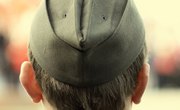
A lie detector, also known as a polygraph, is a machine that ostensibly determines whether a person is telling the truth. During a polygraph test, the lie detector monitors the subject's physiological functions while an expert in psychophysiology interrogates him or her. Although the federal government often uses polygraphs to screen prospective employees for government positions, many view the machines as unreliable and oppose their use as evidence in court.
How Lie Detectors Work
The lie detector measures several physiological functions, depending on the type of detector used. The most common functions that detectors measure are blood pressure, heart rate, rate of respiration and sweat level. A blood pressure cuff placed around the subject's arm measures both blood pressure and heart rate. Two tubes, one around the subject's chest and one around the abdomen, measure the rate of respiration. The air pressure in the tubes changes as the subject breathes. Electrodes called galvanometers, which are connected to the subject's fingertips, measure the sweat level. As the sweat level rises, electrical current flows more freely through the electrodes. The lie detector records all of these physiological responses during the interrogation.
Testing Techniques
The examiner uses several techniques during the test to ensure the most accurate results. For example, most experts say that it is important for the examiner to talk to the subject before the test for the purpose of establishing a baseline for each of the functions being measured. In addition, the examiner will often give a "pretest," which consists of going through all of the questions ahead of time so that the subject knows what to expect. The examiner might also establish that the machine is working correctly by asking a question such as "Have you ever lied before?" and instructing the subject to answer affirmatively.
History
Lie detectors have been in existence in primitive form for a long time. Ancient Hindus determined whether a person was telling the truth by instructing him to spit out a mouthful of rice onto a leaf. A person who was telling the truth would be successful; one who was lying would get the rice stuck in his mouth. This process presumably depended on dryness of the mouth, which is a physiological factor associated with lying. In the nineteenth century, the Italian criminologist Cesare Lombroso used the first lie detection instrument that measured a subject's pulse and blood pressure. In 1921, a student at Harvard named William M. Marston invented the modern polygraph.
Current Uses
In 1988, the U.S. Congress passed the federal Employee Polygraph Protection Act, which disallowed companies from requiring their employees to take a lie detector test. This law, however, does not affect government employees or contractors, including people who work in public schools, libraries or prisons. Therefore, most government employees must undergo a polygraph test as part of the hiring process.
Controversy
Lie detectors are often seen as unreliable. On the one hand, professional criminals can easily learn to slow their heart rates and breathing while lying. On the other, honest people may become so terrified while taking a polygraph test that they may seem to be lying in response to every question. Therefore, many courts refuse to use the results of a lie detector as evidence because they view the devices as inherently unreliable. At the same time, lie detectors are constantly evolving, and engineers are trying to find other ways to more dependably determine whether a subject is answering honestly.
References
About the Author
Keren (Carrie) Perles is a freelance writer with professional experience in publishing since 2004. Perles has written, edited and developed curriculum for educational publishers. She writes online articles about various topics, mostly about education or parenting, and has been a mother, teacher and tutor for various ages. Perles holds a Bachelor of Arts in English communications from the University of Maryland, Baltimore County.
